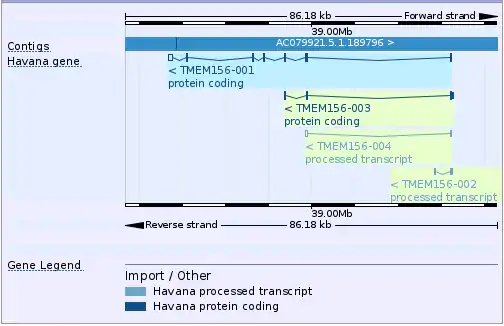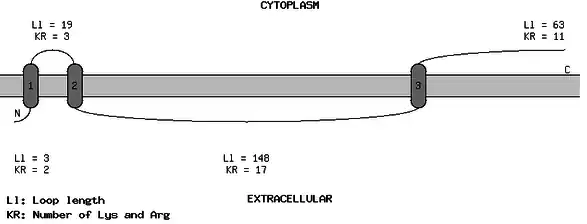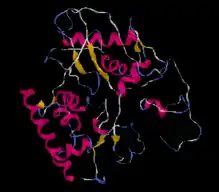TMEM156
TMEM156 is a gene that encodes the transmembrane protein 156 (TMEM156) in Homo sapiens. It has the clone name of FLJ23235.[1]
Gene
Locus
TMEM156 is located on the short arm of Chromosome 4. It is found at position 4p14. It has four known transcripts, only two of which have proteins.[2]
Gene neighborhood
Cytogenetic band: 4p14[2]
The image above shows chromosome four and the various gene locations on it. TMEM156 can be seen at the thin red band that has been placed at p14.
Size
TMEM156 is 66,499 bases and 296 amino acids in length.[4] TMEM156 spans from 38,966,744 to 39,032,922 bp.[5]
mRNA
Splice Variants
TMEM156 has one known splice variant, TMEM156-003. It has one transmembrane region and is 179 amino acids in length resulting in a lower molecular mass of 20.9 kDa.[6] In addition the isoelectric point is 7.0633 and the gene has four transcripts.[7]

| Type | Length | Gene Coordinates |
| Alternative exon 1 | 64 bp | 1 to 64 |
| Alternative exon 2 | 912 bp | 4 to 915 |
| Exon 3 | 270 bp | 11439 to 11708 |
| Exon 4 | 261 bp | 15807 to 16067 |
| Exon 5 | 120 bp | 17760 to 17879 |
| Exon 6 | 84 bp | 19305 to 19388 |
| Exon 7 | 80 bp | 33260 to 33339 |
| Exon 8 | 95 bp | 33907 to 34001 |
| Exon 9 | 37 bp | 37247 to 37283 |
Isoforms
There is one known isoform of TMEM156. This particular isoform uses an alternate in-frame splice site in the 3' coding region. The resulting isoform is shorter than the original.[9]
Protein
Primary structure
The TMEM156 protein is 296 amino acids in length. It has a molecular weight of 34.323 kDa and an isoelectric point of 7.98.[10] The protein interacts with the membrane three total times as seen in the figure below.

Secondary Structure
TMEM156 has a secondary structure composed of primarily α-helices. Phyre was used to create this structure that can be viewed on the right hand side of this article. It is evident that the predicted protein structure is vastly composed of α-helices. The N terminus is located at the top of the image and the C terminus is at the bottom.[12]

Tertiary Structure
This structure was predicted by analyzing the amino acid sequence using I-TASSER. The final result can be see below.[13]

Post-Translational Modifications
Glycosylation at Asn 45 and Asn 156 along with N-glycosylation seen in the portion of the protein that is found in the cytoplasm.[14]
Subcellular Location
The k-NN tool suggests the location of TMEM156 in the Endoplasmic Reticulum of the cell with 44.4% certainty. The following locations were all predicted with 11.1% certainty: vacuolar, vesicles of secretory system, extracellular, plasma membrane, and mitochondrial.[15]
Expression
TMEM156 is expressed in several tissues including ascites, bone marrow, salivary glands, and vascular to name a few. This gene is not ubiquitously expressed, but is still evident in many tissues. This gene is predominately expressed in adults but there is a bit of expression in fetuses.[16]
Interacting Proteins
- C12orf55-chromosome 12 open reading frame 55
- FAM92B-family with sequence similarity 92, member B
- NUGGC-nuclear GTPase, germinal center associated
- plays a role as replication-related GTPase
- CEACAM21-carcinoembryonic antigen-related cell adhension molecule 21
- CPNES-copine V
- may function in membrane trafficking
- exhibits calcium-dependent phosphilipid binding properties
- FCRL1-Fc receptor-like 1
- may function as an activating coreceptor in B-cells
- may function in B-cell activation and differentiation
- MEI1-meiosis inhibitor 1
- required for normal meiotic chromosome synapsis
- may be involved in meiotic double strand breaks
- MZB1-marginal zone B and B1 cell-specific protein
- associates with immunoglobulin M (IgM) both heavy and light chains
- promotoes IgM assembly and secretion
- associates with immunoglobulin M (IgM) both heavy and light chains
- SPAG4-sperm associated antigen 4
- may assist the organization and assembly of outer dense fibers (specific fibers to the sperm tail)
- SLC17A9-solute carrier family 17, member 9
- involved in vesicular storage and exocytosis of ATP[17]
Homology
Transmembrane protein 156 has one known paralog. It also has various orthologs within eukaryotes. The table below compares an overarching sample of the known orthologs and one paralog.[18] The specific lineage of TMEM156 is: Eukaryota; Metazoa; Chordata; Craniata; Vertebrata; Euteleostomi; Mammalia; Eutheria; Euarchontoglires; Primates; Haplorrhini; Catarrhini; Homindae; Homo.[1]
| Organism | Common Name | Accession Number | Sequence Identity | Sequence Similarity | Notes |
| Homo sapiens | Humans | XP_011512056 | 100% | 100% | Mammal |
| Phycicoccus sp. Root101 | WP_056919608 | 36% | 56% | Archaea | |
| Medicago truncatula | barrel medic | XP_003600988 | 52% | 73% | Plantae |
| Acanthisitta chloris | rifleman | KFP78611 | 28% | 49% | Aves |
| Struthio camelus australis | KFV80462 | 30% | 48% | Aves | |
| Chaetura pelagica | chimeny swift | KFU95974 | 31% | 50% | Aves |
| Tauraco erythrolophus | red-crested turaco | XP_009989935 | 32% | 48% | Aves |
| Chlamydotis macqueenii | Macqueen's bustard | XP_010113687 | 33% | 50% | Aves |
| Chelonia mydas | green sea turtle | XP_007059764 | 35% | 54% | Reptile |
| Alligator mississippiensis | america alligator | XP_006273714 | 36% | 56% | Reptile |
| Dasypus novemcinctus | nine-banded armadillo | XP_004459440 | 73% | 81% | Mammal |
| Felis catus | domestic cat | XP_006931228 | 68% | 77% | Mammal |
| Panthera tigris altaica | amur tiger | XP_007098927 | 69% | 78% | Mammal |
| Bubalus bubalis | water buffalo | XP_006066188 | 72% | 83% | Mammal |
| Capra hircus | goat | XP_005681569 | 72% | 83% | Mammal |
| Leptonychotes weddellii | weddell seal | XP_006732368 | 72% | 82% | Mammal |
| Ovis aries | sheep | XP_012035193 | 73% | 84% | Mammal |
| Bison bison bison | bison | XP_010831883.1 | 74% | 84% | Mammal |
| Camelus bactrianus | bactrian camel | XP_010960972 | 74% | 85% | Mammal |
| Vicugna pacos | alpaca | XP_015099523 | 75% | 86% | Mammal |
| Pteropus vampyrus | large flying fox | XP_011364299 | 79% | 89% | Mammal |
| Homo sapiens | humans | NP_061028.3 | 47% | 58% | Mammal |
References
- "TMEM156 transmembrane protein 156 [Homo sapiens (human)] - Gene - NCBI". www.ncbi.nlm.nih.gov. Retrieved 2016-05-08.
- "Gene: TMEM156". e!Ensembl. Ensembl. March 2016. Retrieved April 27, 2016.
- "genecards.org/cgi-bin/carddisp.pl?gene=tmem156". www.genecards.org. Retrieved 2016-05-03.
- "genecards.org/cgi-bin/carddisp.pl?gene=TMEM156". www.genecards.org. Retrieved 2016-04-27.
- "Gene: TMEM156 (OTTHUMG00000128582) - Summary - Homo sapiens - Vega Genome Browser 64". vega.sanger.ac.uk. Retrieved 2016-05-05.
- "Tissue expression of TMEM156 - Summary - The Human Protein Atlas". www.proteinatlas.org. Retrieved 2016-05-05.
- "Ensembl genome browser 78: Homo sapiens - Protein summary - Transcript: TMEM156-003 (ENST00000344606)". dec2014.archive.ensembl.org. Retrieved 2016-05-05.
- [email protected], Danielle Thierry-Mieg and Jean Thierry-Mieg, NCBI/NLM/NIH. "AceView: Gene:Tmem156, a comprehensive annotation of human, mouse and worm genes with mRNAs or ESTsAceView". www.ncbi.nlm.nih.gov. Retrieved 2016-05-03.
- "TMEM156 transmembrane protein 156 [Homo sapiens (human)] - Gene - NCBI". www.ncbi.nlm.nih.gov. Retrieved 2016-05-04.
- "TMEM156 - Transmembrane protein 156 - human protein (Proteomics)". www.nextprot.org. Retrieved 2016-05-04.
- "TopPred". mobyle.pasteur.fr. Retrieved 2016-05-04.
- "Phyre 2 Results for Undefined". www.sbg.bio.ic.ac.uk. Retrieved 2016-05-06.
- "I-TASSER server for protein structure and function prediction". zhanglab.ccmb.med.umich.edu. Retrieved 2016-05-08.
- "TMEM156 - Transmembrane protein 156 - human protein (Proteomics)". www.nextprot.org. Retrieved 2016-04-27.
- "PSORT WWW Server". psort.hgc.jp. Retrieved 2016-05-05.
- "EST Profile - Hs.374147". www.ncbi.nlm.nih.gov. Retrieved 2016-05-04.
- "TMEM156 protein (Homo sapiens) - STRING network view". string-db.org. Retrieved 2016-04-28.
- "BLAST: Basic Local Alignment Search Tool". blast.ncbi.nlm.nih.gov. Retrieved 2016-02-29.
